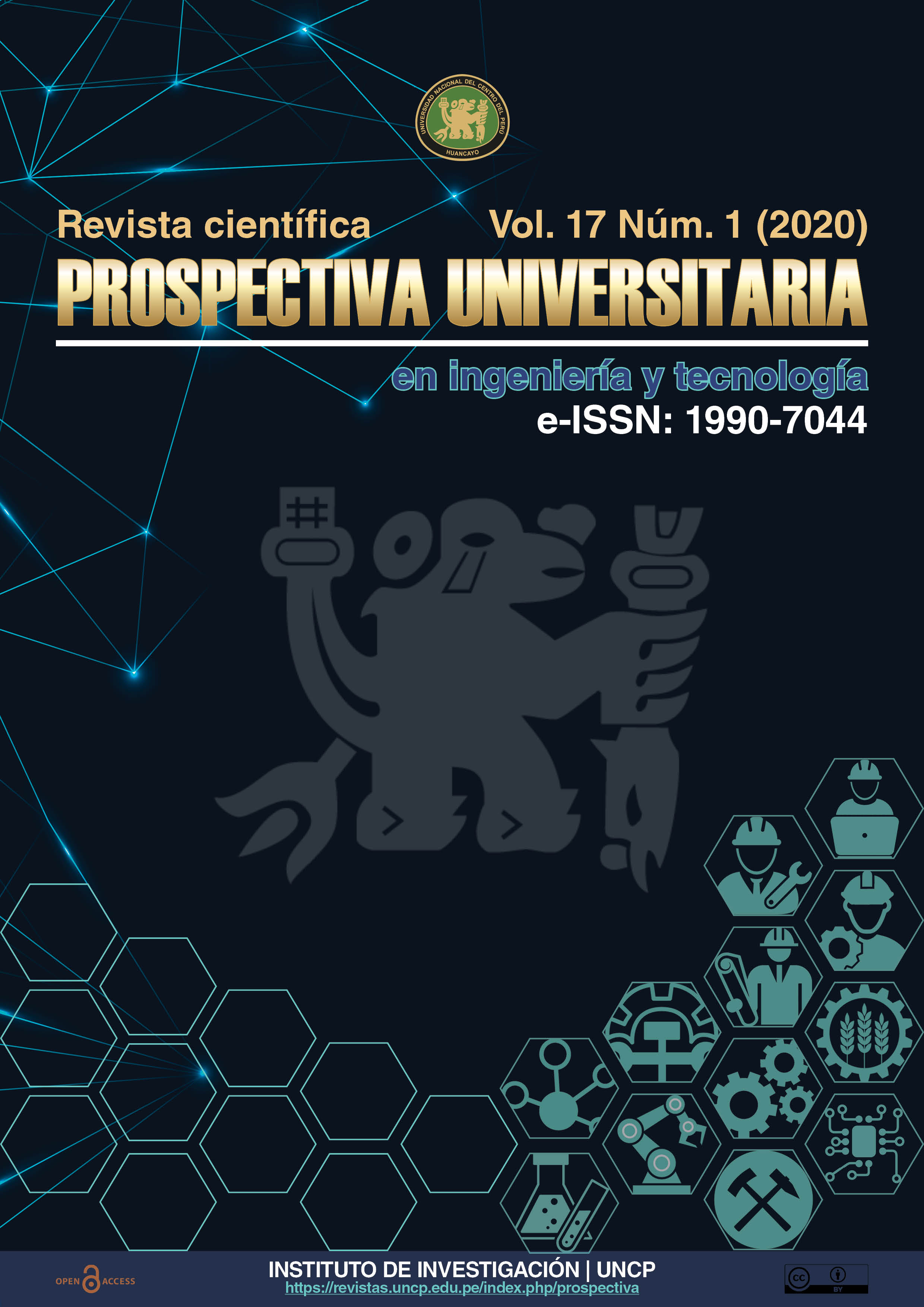Evaluación de la remoción de materia orgánica del lixiviado mediante el proceso de electrocoagulación del botadero La Mejorada El Tambo
DOI:
https://doi.org/10.26490/uncp.prospectivauniversitaria.2020.17.1393Palabras clave:
Remoción de materia orgánica, Lixiviado, Electrocoagulación, Contaminación, Carga orgánicaResumen
El objetivo de la presente investigación fue determinar la eficiencia de una celda de electrocoagulación a escala de laboratorio para el tratamiento del lixiviado del botadero La Mejorada, donde se encontró valores de DQO 9962,6 mg/l, DBO5 6822,5 mg/l, conductividad eléctrica igual a 3620,0 μSm/cm y sólidos totales 4297,0 mg/l, valores que sirvieron como referencia para iniciar el trabajo. Con base en los resultados obtenidos al realizar el tratamiento con electrocoagulación, se determinó una eficiencia de hasta 91 % de la DQO y un 94 % en la DBO5, trabajando con pH 8 y tensión de corriente de 20 v e iniciando con un pH neutro en la muestra. Se debe tener en cuenta que no se tienen LMP para los lixiviados, por lo que, al comparar con los LMP para efluentes de PTAR, los resultados obtenidos no se encuentran dentro de los parámetros permitidos, por lo cual, se debe realizar un tratamiento adicional complementario.
Sin embargo, en la conclusión se determinó la composición físico química del lixiviado del botadero La Mejorada, así como el tiempo de retención hidráulica óptimo mediante el método de electrocoagulación con un voltage administrado de 20 v, obteniéndose, de esta manera, una disminución de la carga orgánica de hasta el 90 %.
Descargas
Referencias
Arango. (2005). La electrocoagulación: Una alternativa para el tratamiento de aguas residuales. Revista Lasallista de Investigación, 49-56.
Barkley. (1993). Alternating current electrocoagulation for superfund site remediation.
Barrera, C. E. (2014). Historia y evolucion de la electrocoagulacion. En aplicaciones electroquímicas al tratamiento de aguas residuales. (págs. 165-180). Reverte.
Chen. (2004). Electrochemical technologies in wastewater treatment. Separation and Purification Technology, 11–41.
Chen & Sheng. (2003). Ingeniería Química Ciencia. China.
Cisneros, J. (2001). La contaminación ambiental en México. Limusa Noriega editores, 409-505.
Diamadopoulos. (1994). Characterization and treatment of recirculation - stabilized leachate. Water Research., 23, 2439-2445.
Diaz, C. E. (2014). Aplicaciones electroquímicas al tratamiento de aguas residuales. Reverte.
Foth, D. H. (1997). Fundamentos de la ciencia del suelo. CECSA, 207-214, 365-370.
García, F. C. (2012). Electrocoagulación: una alternativa para depuración de lactosuero residual. AIDIS, 62-64.
Gobierno del Distrito Federal, D. (2002). Resumen ejecutivo sobre el monitoreo ambiental realizado en el sitio de disposición final en operación “Bordo Poniente". Dirección Técnica de Desechos Sólidos.
Holt. (2003). Electrocoagulation. PhD thesis, Faculty of Engineering, The University of Sydney.
Huijuan Liu, X. Z. (2010). Electrocoagulacion en el tratamiento de agua. En X. Z. Huijuan Liu, Electroquimica del Medio Ambiente (págs. 245-262). Nueva York: Springer.
J., S. C. (2005). Contamina un derrame de lixiviados cultivos de Chiconautla y Totolcingo. La Jornada, 50,95.
Krishnam Rajeshwar, J. G. (1997). Electroquímica ambiental: Fundamentos y aplicaciones en reducción de la contaminación. Prensa académica.
Méndez N., C. S. (2002). Influencia del material de cubierta en la composición de los lixiviados de un relleno sanitario.
Mollah. (2001). La ciencia y aplicaciones. EE.UU. / Bangladés / México.
Mollah. (2004). Fundamentals, present and future perspectives of electrocoagulation. Journal of Hazardous Materials.
Mollah, M. &. (2001). Electrocoagulation (EC). Science and applications: Journal of Hazardous Materials, 29-41.
Ogutveren. (1992). Journal of Environmental Science.
Phutdhawong. (2000). Analytical Science (Vol. vol. 16). The Japan Society of Analytical Chemistry.
Prentice G. (1990). Electrochemical Engineering. National Science Foundation.
Restrepo. (2006). La electrocoagulación: retos y oportunidades en el tratamiento de aguas. Producción + Limpia, 58-77.
Ríos. (2005). The passivation of the electrode in the electrocoagulation process. Portugaliae Electrochimica Acta 23, (págs. 17-34). Mexico.
Skoog. (2001). Química Analítica. Nueva York, Estados Unidos: edición, McGraw-Hill.
Social, S. d. (2001). Manuales técnicos para el manejo de la basura ¡Por un México Limpio! (SEDESOL).
Tchobanogluos, T. A. (1994). Gestión integral de residuos sólidos. Mc Graw-Hill / Interamericana, 120-128, 407-502.
Víctor, E. & Reyes Cruz, Y. M. (5 de Enero de 2012). ADIS. ECURED - Conocimiento con todos y para todos: http://www.ecured.cu/index.php/Cromo
Walsh. (2001). Pure and applied chemistry.
Descargas
Publicado
Número
Sección
Licencia
Derechos de autor 2020 César Augusto Loayza Morales

Esta obra está bajo una licencia internacional Creative Commons Atribución-NoComercial-CompartirIgual 4.0.
Esta Revista es de acceso abierto a su contenido a través del Internet, poniendo a disposición de la comunidad científica los resultados de la investigación, de manera gratuita, para el intercambio del conocimiento desarrollado.
El contenidos de la Revista se distribuyen bajo la licencia Creative Commons Reconocimiento-NoComercial-CompartirIgual 4.0 Internacional.
![IconJournalPU [ESP] by Edgar Julian-Laime®](https://revistas.uncp.edu.pe/public/journals/1/pageHeaderLogoImage_es.png)









